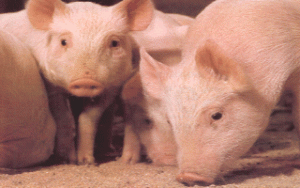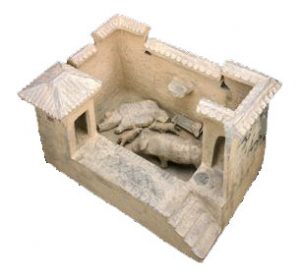
History of pigs: A wild boar
Where do pigs come from?
The first pigs evolved in Southeast Asia from earlier, smaller mammals, about two million years ago, and spread out from there all over Eurasia and Africa.
The Quaternary period
Central Asian food history
Wild pigs live in forests, especially where there are oak trees that make acorns, because pigs like to eat acorns. People first met pigs before they left Africa; they cooperated with dogs and used spears and nets to hunt wild pigs in the forest.
Where do dogs come from?
More about hunting
We call male wild pigs boars. Wild boars are very dangerous to hunt. They are big and smart and they have long sharp tusks and teeth. Probably men hunted them mainly in order to look cool and impress girls. But also, bacon.

Domesticated pigs
Domesticated pigs
It is much safer to domesticate pigs and have them tame, although even tame pigs can still be very dangerous (still, people are more dangerous to pigs than pigs are to people!).
Food in early China
History of Vietnam
Early African food
People first began to keep tame pigs about 10000 BC, in Central Asia. From Central Asia, tame pigs spread slowly east to China and Vietnam (by around 2000 BC), and south-west to West Asia and North Africa.
Pigs in Europe
People also tamed pigs separately in Europe, maybe about the same time. In central Europe (what’s now southern Germany and Austria), people combined their pigs with the salt from the big salt mines there and got really good at preserving pig meat by making it into hams and bacon and sausages.
Making bacon: a project
History of salt
Northern Europe’s food
Pigs were a very popular source of food all through antiquity, from West Asia all the way west to to England and east to China, from Scandinavia to North Africa. Pigs care for themselves pretty independently, and they will eat apple cores and rotten meat and peapods, so you can feed them on garbage. Pig meat’s easy to preserve with salt, and bacon and ham are delicious, fatty, salty foods.
Video of a pig
Egyptian taboo on eating pork
But from at least 1500 BC, Egyptian people seem to have thought that pigs were kind of yucky, something only poor people would eat. Possibly as a result of Egyptians conquering them during the New Kingdom, most Semitic people in West Asia, including not only most Jews but also other people like the Phoenicians and the Arabs, would not eat pig meat. The Bible says that Jews should not eat pig meat. Further south in India, too, most people did not eat pig meat.
Food in ancient Egypt
Who were the Jews?
West Asian religions

Pigs in medieval Europe (Très Riches Heures, ca. 1415 AD)
The Philistines and the Romans
At the end of the Bronze Age, when the Greeks invaded Israel and settled there as the Philistines, they brought European pigs with them to Israel.
Philistines in Israel
The end of the Bronze Age
Roman food
That would have been another reason why the Jews didn’t like the Philistines – they kept pigs. Probably the Hellenistic Greeks and the Romans, too, when they conquered Israel, brought European pigs with them.
Christians decide to eat pork
The earliest Christians, who lived in Israel, like the Jews did not eat pork, but by about 50 AD many Christians came from places where people did eat pork, like Greece, and the Christians decided that this rule did not apply to them.
History of Christianity

Han Dynasty latrine: you climbed the stairs to the little house to go to the bathroom, and the pig could eat what fell to the ground and recycle it. (Art Institute of Chicago)
Islam and pork
When Mohammed told the Arabs about the new religion of Islam, he also said that Muslims (people who followed Islam) should not eat pork. The Quran forbids Muslims to eat pork.
Islam and pork
What is the Quran?
So pigs became much less common around the Mediterranean and in West Asia after about 700 AD, and they are still very uncommon today. But in Europe and in China, where people were Christian or Buddhist or Taoist and not Muslim, pigs remained very common.
Pigs in the Americas
There were no pigs in the Americas before European settlers came to the Americas in the 1400s AD. They brought pigs with them. Pork became part of Mexican food and Native American food and South American food. But when the tame pigs escaped, there weren’t any natural enemies to eat them. Today, there are a lot of feral pigs – wild pigs descended from tame pigs – all over the American West and the South.
Learn by doing: salt your own bacon
Pork in Chinese food
Pork in German food
Bibliography and further reading about the history of pigs:




